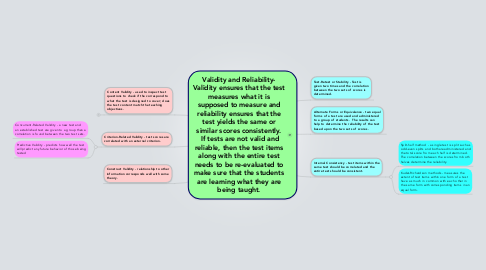Validity and Reliability- Validity ensures that the test measures what it is supposed to measure and reliability ensures that the test yields the same or similar scores consistently. If tests are not valid and reliable, then the test items along with the entire test needs to be re-evaluated to make sure that the students are learning what they are being taught.
by Douglas Speeckaert

1. Content Validity - used to inspect test questions to check if the correspond to what the test is designed to cover; does the test content match the teaching objectives.
1.1. New node
1.2. New node
2. Criterion-Related Validity - test scores are correlated with an external criterion.
2.1. Concurrent-Related Validity - a new test and an established test are given to a group then a correlation is found between the two test sets.
2.2. Predictive Validity - predicts how well the test will predict any future behavior of those being tested
3. Construct Validity - relationship to other information corresponds well with some theory.
4. Test-Retest or Stability - Test is given two times and the correlation between the two sets of scores is determined.
5. Alternate Forms or Equivalence - two equal forms of a test are used and administered to a group of students. The results can help to determine the reliability of the test based upon the two sets of scores.
6. Internal Consistency - test items within the same test should be correlated and the entire test should be consistent.
6.1. Split-half method - a single test is split such as odd-even splits and bothare administered and the total score from each half is determined. The correlation between the scores from both halves determine the reliability.
6.2. Kuder-Richardson methods - measures the extent of test items within one form of a test have as much in common with each other in the same form with corresponding items in an equal form.


